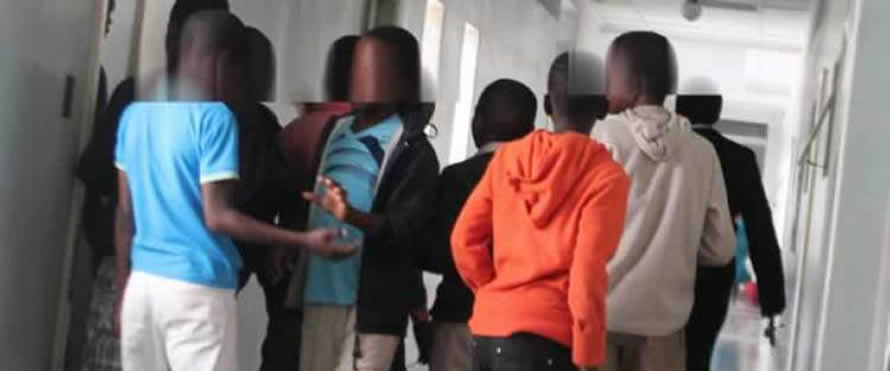
The Sunday Mail

In-Depth Reporter
It is break-time and a group of Form One girls are strolling leisurely in one of the school’s playing fields.
An older boy appears in front of the girls and targets one of them.He blocks the girl’s way and without her consent begins to fondle her small breasts. Despite the girl’s protests, the boy continues to abuse her in broad daylight.
This scenario is common in secondary schools and it extends to the streets and homes where girls are subjected to sexual, physical and emotional abuse.
According to the Girl Child Network, at least 100 girls in Zimbabwe are sexually abused every day.
The Zimbabwe Republic Police Victim Friendly Unit says an average of 10 girls were raped daily in 2013.
Sexual abuse is, however, not only perpetrated against girls. Research has shown that there is an increase in reports of boys being sexually abused, mainly in schools.
Despite concerted efforts by key stakeholders such as the Ministry of Women’s Affairs, Gender and Community Development, Ministry of Primary and Secondary Education, the Department of Social Welfare and non-governmental organisations, cases of child sexual abuse are on the increase.
According to the recently released Zimbabwe National Statistics Agency’s (ZimStat) 2012 National Baseline Survey on Life Experiences of Adolescents Report, sexual abuse includes sexual touching, kissing, grabbing, fondling, attempted sex, sexual penetration and pressured sex through the use of threats, luring, harassment or trickery.
“The most prevalent form of sexual abuse experienced by females before reaching the age of 18 was forced touching or fondling,” states the latest report.
It is further said that the most frequently reported form of sexual violence among females aged between 18 and 24 is attempted sex.
“Sexual touching was the highest form of sexual violence experienced by males, followed by attempted sex,” the report stated.
“About 21 percent of schoolchildren have at some point been sexually abused during their adolescence, while 33 percent of females aged between 18 and 24 years have also suffered the same form of abuse and 9 percent of males in the same age category, experienced some form of sexual violence.
Evidence shows that the most common types of sexual abuse are similar for male and females, but the prevalence rate is significantly higher for females.
Females are at least three times more likely to be sexually abused than their male counterparts.
About three quarters of females aged between 18 and 24 reported that the first incident of sexual abuse was perpetrated by a boyfriend while about 10 percent cited neighbours as perpetrators of the sexual abuse.
According to Ms Kumbirai Kahiya, a girl child rights activist, a number of factors are behind the increase in the number of sexual abuse cases.
“There are a lot of misconceptions about girls. The harsh economic climate exposes girls to potential sexual abuse perpetrators.
“We have girls that sell various wares to help their families survive and these girls are exposed to potential abusers,” Ms Kahiya said.
Experts say victims of sexual abuse usually develop physical and emotional scars that haunt them for the rest of their lives.
According to a Zimbabwe Youth Council Report on Eliminating Harmful Social and Cultural Practices Affecting Children: Our Collective Responsibility: “It is interesting to note that . . . While child sexual abuse is a common practice, it is highly under-reported because it is mostly committed by people that are close to the victims.”
Apart from sexual abuse, it also emerged that nearly half of Zimbabwean girls face physical violence, yet only one in four of the alleged perpetrators is arrested.
Zimbabwe is signatory to various ratifications on the protection of children’s rights.
The country also has laws such as The Children’s Act (Chapter 5:06), specifically enacted to protect the interests of children.
However, despite the laws, many children continue falling victim to abuse.
A recent survey by the United Nations Population Fund (UNFPA) revealed that 31 percent of Zimbabwean girls under the age of 18 were in forced marriages.
The survey further stated that 15 percent of the girls got married at the age of 15.
Statistics show that 16,3 percent of the Zimbabwean population is married before the age of 15 years.
According to research, the majority of the girls were pushed into early marriages by poverty, cultural norms and other social, economic and religious practices.
Ms Moline Mvundura, an activist who champions the cause of the girl child, told The Sunday Mail In- Depth that society was to blame for the increase in the number of sexual abuse cases.
“We have situations in which family members are protecting perpetrators of child abuse. Family members are also failing to caution and counsel girls whose behaviour exposes them to potential sexual abusers,” Ms Mvundura said.
Organisations such as Musasa Project, Adult Rape Clinic, Family Support Trust and New Start have instituted campaigns to fight both child sexual abuse and rape.
At national level, laws and policies such as the National Gender Policy also seek to protect women and the girl child from abuse.
However, despite such advocacy groups and regulations, children continue to face abuse and in most cases they suffer in silence.




